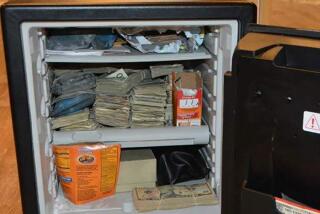A Stranger to Glory, Boxer Now Fights Just to Survive
- Share via
You can see the California Hospital Medical Center from the corner of 11th and Figueroa, right outside Staples Center. The buildings are only 4 1/2 blocks apart, and you wonder about the fickle turns of fate that brought Ruben Contreras to both of those places Saturday.
Contreras was called in from Mexico as a last-minute replacement when Brian Viloria’s opponent withdrew last week. In boxing’s limited pool of flyweights, many of whom can be found in Mexico, Contreras was a perfect candidate. He was a credible opponent and, more important, he had a visa and his medical records were in order. There was nothing to indicate that a nondescript fight could force him into a seizure and jeopardize his life.
But something went horribly wrong after the fight was stopped in the sixth round and Viloria was declared the winner by technical knockout. Contreras complained of double vision and a headache, then suffered a seizure. He was taken to California Hospital Medical Center, where doctors operated to relieve pressure caused by bleeding around his brain.
As of Sunday, he was in a medically induced coma, listed in critical condition.
It’s always a risk in boxing, but one that never fails to stun and sober.
“You just ... “ Viloria’s manager Gary Gittelsohn started. “You never know.”
*
I caught an old Muhummad Ali fight from 1970 on ESPN Classic on Sunday morning. Whenever I see the young, flamboyant Ali, it makes me a little sad to think of today’s version, practically muted by Parkinson’s disease. Then I heard the news about Contreras and realized Ali isn’t the one we should feel sorry for.
Ali enjoyed all the benefits. He traveled the world, received its riches, ate with kings, basked in glory.
Most boxers assume all the same risks as Ali, and never get the rewards.
The 32-year-old Contreras toiled in obscurity. Viloria’s trainer, Ruben Gomez, has more than 10,000 fights in his video collection, but when he started his preparation he couldn’t find one match with Contreras. Gomez knew Contreras had fought Will Grigsby, but when he sent for a tape from Grigsby’s camp, it turned out the fighter was another man named Ruben.
Even when Contreras was in the ring in Staples Center, he was a long way from glory.
It was late Saturday afternoon, the second fight of a 10-bout card headlined by legendary Julio Cesar Chavez versus Ivan Robinson.
Only a smattering of fans had made their way into the arena.
“If there were 1,500 people in the stands, I’d be surprised,” Gittelsohn said.
Contreras didn’t even have any family members padding the attendance. His aunt and uncle live in the Los Angeles area and they weren’t even aware that he was in town for a fight.
The action did little to generate excitement. Viloria was winning, but, “It wasn’t like a one-sided beating,” Gomez said.
There were no knockdowns.
It was, Gittelsohn said, “a boring fight.”
There’s no way of knowing now whether Contreras had a preexisting condition that led to this injury. California doesn’t require boxers to have a CT scan before they are licensed to fight.
Perhaps it was inevitable, or maybe it was just a freak occurrence, pure misfortune.
But amid the tragedy, Contreras got a break. The trauma center at California Hospital Medical Center, a project three years in the making, just opened on Dec. 1.
With time an essential element, help couldn’t have been any closer.
“The fact that he came for an early operation saved his life,” said Dr. David Duarte, one of the surgeons who operated on Contreras Saturday night. “Because he would have had irreversible brain damage if he had waited more than 30 minutes longer.”
They finished surgery around 9 p.m. Saturday. Contreras is in a medically induced coma for a 72-hour period that will end Tuesday, and will be re-evaluated then.
So far, so good.
“Everything that could go right has gone right,” Duarte said.
But with brain injuries the prognosis can change at any time. “After 72 hours they could be brain-dead,” he said.
So much is unknown about Contreras’ future. So much is unknown about him. His family members did not wish to speak to the media Sunday.
Gomez, unable to find any film of Contreras, was able to glean this from other trainers whose boxers had fought him: “Blue-collar type of fighter, he comes in. He’s not going to lay down.”
We can only hope those same qualities come to his aid now.
The hospital complex stretches from one street all the way to another, meaning Contreras is between Hope and Grand. When you think about it, isn’t that where all boxers are?
J.A. Adande can be reached at [email protected]. To read previous columns by Adande, go to latimes.com/adande.
More to Read
Go beyond the scoreboard
Get the latest on L.A.'s teams in the daily Sports Report newsletter.
You may occasionally receive promotional content from the Los Angeles Times.









